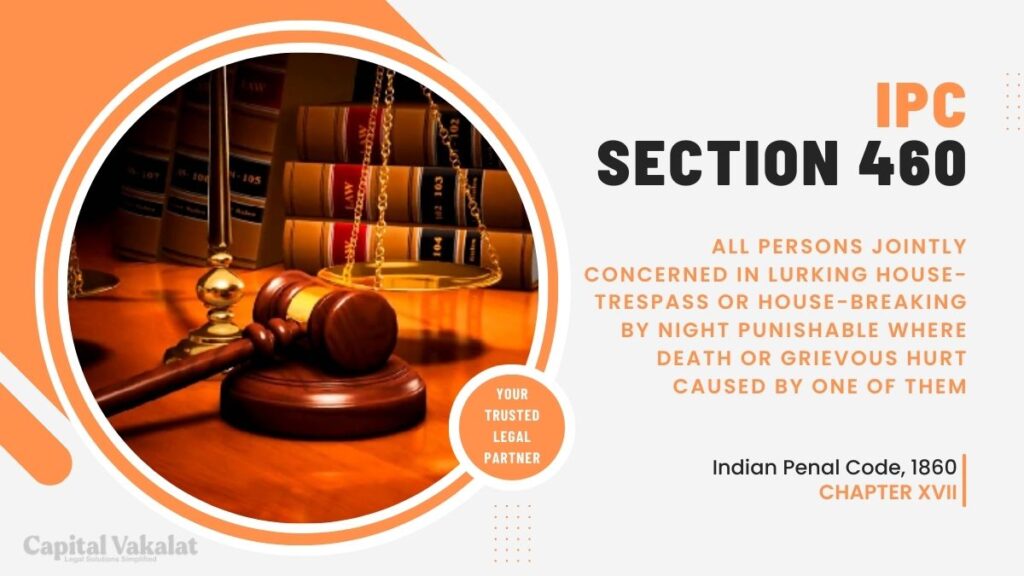In the labyrinth of legal provisions, Section 460 of the Indian Penal Code (IPC) stands as a sentinel against acts of joint criminality involving lurking house-trespass or house-breaking by night.

This article delves into the intricacies of Section 460, examining its components, the gravity of offenses it addresses, legal interpretations, and its practical implications.
Introduction to Section 460 IPC
Section 460 of the IPC encapsulates the legal consequences for individuals engaged in jointly committed offenses related to lurking house-trespass or house-breaking by night. It establishes a framework for holding all involved parties accountable when such actions result in death or grievous hurt.
Understanding Jointly Concerned Offenses
Definition of Lurking House-Trespass
Lurking house-trespass involves entering a dwelling surreptitiously with an intent to commit an offense. Understanding the nuances of this term is crucial to grasp the scope of Section 460.
Definition of House-Breaking by Night
House-breaking by night, as outlined in Section 460, pertains to the act of breaking into a residence during the night hours. This section casts a spotlight on the severity of crimes committed under the cover of darkness.
Punishments Under Section 460 IPC
The crux of Section 460 lies in the consequences it prescribes when death or grievous hurt results from the joint actions of the offenders. Unpacking the legal repercussions sheds light on the gravity of such offenses and the intent behind stringent penalties.
Death or Grievous Hurt Caused by One of the Offenders
The severity of the punishment under Section 460 is directly linked to the outcome of the criminal act. If the actions of one or more individuals lead to death or grievous hurt, the law mandates collective accountability.
Legal Perspectives and Precedents
To comprehend the practical application of Section 460, exploring landmark cases becomes imperative. Legal precedents provide insights into judicial interpretations and the evolution of the legal framework surrounding this section.
Landmark Cases Interpreting Section 460
Analyzing significant legal cases helps in understanding the court’s approach to interpreting and applying Section 460. This section provides a glimpse into the evolution of jurisprudence in this domain.
Significance of Night-time Offenses
Increased Vulnerability and Risks
Night-time offenses present unique challenges and increased vulnerability for victims. Section 460 recognizes this heightened risk and addresses the severity of crimes committed under the cover of darkness.
Analysis of Joint Criminal Liability
Establishing Shared Criminal Intent
Proving joint criminal liability involves establishing shared intent among the offenders. This section explores the challenges and complexities in determining collective culpability in crimes falling under Section 460.
Challenges in Proving Joint Offenses
Section 460 introduces challenges in the legal landscape, requiring a nuanced understanding of joint offenses. The article explores the difficulties in establishing the involvement of multiple parties in a coordinated criminal act.
Role of Evidence in Section 460 Cases
Circumstantial Evidence and Its Weight
The role of evidence in cases falling under Section 460 cannot be overstated. This section delves into the significance of circumstantial evidence and its weight in establishing guilt or innocence.
Critiques and Debates Surrounding Section 460
Controversial Aspects of the Section
As with any legal provision, Section 460 is not without its controversies. This section scrutinizes the criticisms and debates surrounding the application and implications of this particular provision.
Calls for Reforms and Amendments
In light of evolving societal norms and legal perspectives, calls for reforms and amendments to Section 460 have emerged. Exploring these proposals provides a holistic view of the ongoing discourse.
Real-life Scenarios and Case Studies
Notable Cases Illustrating Section 460
Examining real-life scenarios and case studies provides practical insights into the application of Section 460. This section discusses notable cases, highlighting the diverse circumstances and outcomes.
Conclusion
In conclusion, Section 460 of the IPC serves as a legal bulwark against jointly committed offenses involving lurking house-trespass or house-breaking by night. Its nuances, interpretations, and practical implications underscore the gravity of crimes committed in collaboration.
Frequently Asked Questions
Can joint criminal liability be established solely based on circumstantial evidence?
Yes, circumstantial evidence plays a crucial role in establishing joint criminal liability under Section 460, but its weight depends on the specific circumstances of each case.
Are there any proposed amendments to Section 460?
There have been discussions about potential reforms to Section 460, reflecting the evolving legal landscape and societal expectations. However, as of now, no formal amendments have been enacted.
What distinguishes lurking house-trespass from regular trespass?
Lurking house-trespass involves entering a dwelling surreptitiously with the intent to commit an offense, distinguishing it from regular trespass, which may not involve criminal intent.
How does Section 460 address unintentional harm caused during joint offenses?
Section 460 focuses on instances where death or grievous hurt results from joint criminal actions. Unintentional harm may be considered, but the severity of the harm influences the legal consequences.